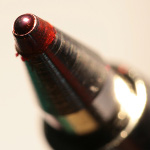 The ink pen used to be a very simple instrument. It was a feather from a bird’s wing that was dipped into a bottle of ink to transfer it onto paper as text or drawings. These days, ink pens are much more sophisticated. Manufacturers are competing fervently with each other. They’ve engineered so many different ink pen varieties with various features that they’ve saturated us with choices.
The ink pen used to be a very simple instrument. It was a feather from a bird’s wing that was dipped into a bottle of ink to transfer it onto paper as text or drawings. These days, ink pens are much more sophisticated. Manufacturers are competing fervently with each other. They’ve engineered so many different ink pen varieties with various features that they’ve saturated us with choices.
Consumers often say that, when confronted with a plethora of choices, they’ll start feeling overwhelmed and won’t pick anything at all. This guide is meant to help you narrow down the options available, and help you choose the best type of pen for your needs.
First, review the five basic categories of modern ink pens. They are split up according to how the ink is dispensed. Then, review the list of optional features at the bottom of the post.
1. Ballpoint
 This, the most common type of pen available, is also known as a biro or ball pen. Manufacturers have refined the process of making ballpoints; thus it has become the most economical, inexpensive kind of pen to purchase.
This, the most common type of pen available, is also known as a biro or ball pen. Manufacturers have refined the process of making ballpoints; thus it has become the most economical, inexpensive kind of pen to purchase.
The ink is non-water based and does not smudge when applied to paper. This makes the ballpoint a great choice for users who are left-handed. The pen works very well on thin papers such as multiple-part business forms. Its ink performs well by being permanent, without fading over time. It is highly recommended for record-keeping.
The tip can be fine-, medium-, or bold-sized.
2. Advanced Ink System
Pens with advanced ink systems are designed to reduce the friction between the tip and the writing surface. This creates a superior, smoother writing experience than ballpoints by requiring minimal pressure from the user’s hand. The ink is similar in composition to that of ballpoints, but has a unique viscosity. Once applied, the ink dries quickly for minimal smearing.
The tip is medium-sized.
3. Porous Point
Porous point pens contain a tip made of a kind of porous material such as felt or ceramic. The ink dries quickly and resists smearing. It won’t bleed through paper to be visible on the other side. Manufacturers produce these pens in a wide variety of colors. These pens write smoother than ballpoints. A pen with a felt tip is excellent for making bold marks.
The tip can be fine- or medium-sized.
4. Gel
Gel pens have ink in which color pigments are held in a water-based gel. The ink is thick and opaque, thus is better suited for slicker or darker surfaces than other types of pens. The consistency of the gel allows many more varieties of color pigments to be utilized. These pens write smoother than ballpoints.
Gel pens do have a few negative points: they can leak if the stopper fluid runs out; they use ink up faster than other pens; and they can smear due to water-based ink. However, these downsides are offset by certain advantages, such as being able to write on smooth, non-absorbent materials.
The tip can be ultra micro-, micro-, needle-, medium- or bold-sized.
5. Rollerball
 A relatively recent invention, the rollerball pen writes smoother than any other type of pen. The water-based ink is applied skip-free and requires minimal exertion from the hand. They write smoother than any other type of pen.
A relatively recent invention, the rollerball pen writes smoother than any other type of pen. The water-based ink is applied skip-free and requires minimal exertion from the hand. They write smoother than any other type of pen.
The tip can be micro-, needle-, fine- or bold-sized.
Optional Features
- Antimicrobial coating
- Cap
- Clip
- Cushioned grip
- Flashlight combo
- Imprinted barrel and/or clip
- Jumbo or miniature barrel size
- Made from recycled materials
- Multiple ink colors
- On a rope, lanyard, or chain
- Pink Ribbon breast cancer awareness
- Plunger or twist retractable action
- Premium barrel material: chrome, leather, gold, silver, etc.
- Refillable or replaceable ink cartridge
- Rotating custom messages inside the barrel
- Stylus combo for drawing on touch screens
- Visible ink reservoir

